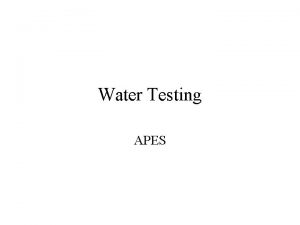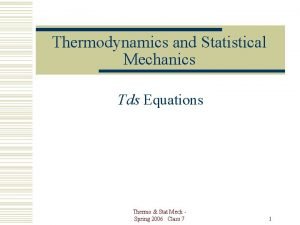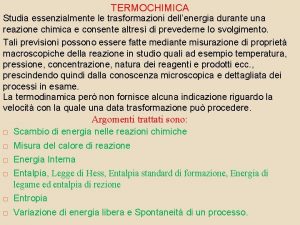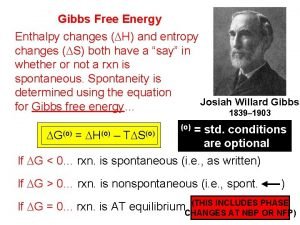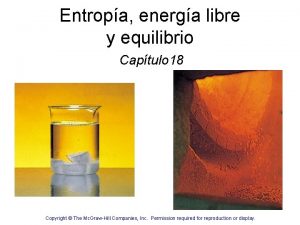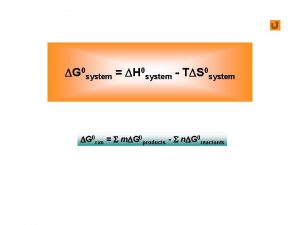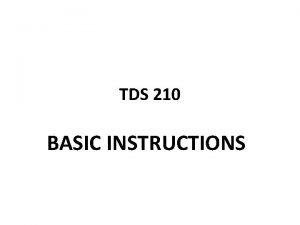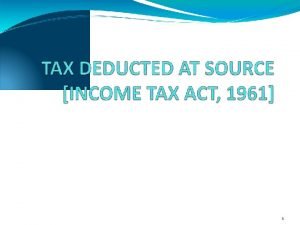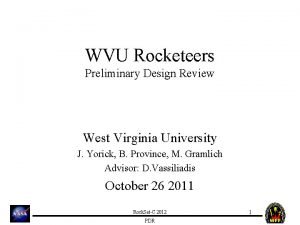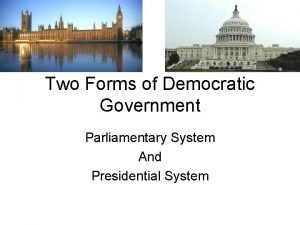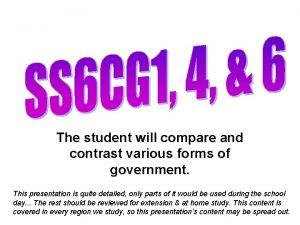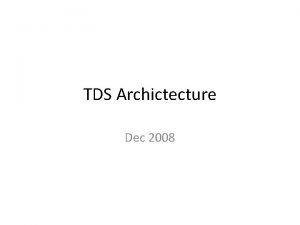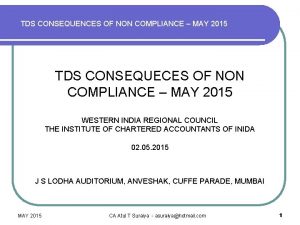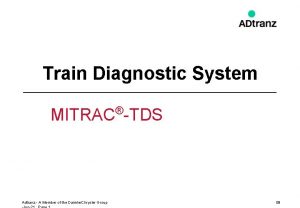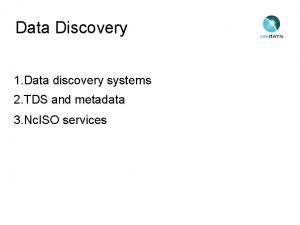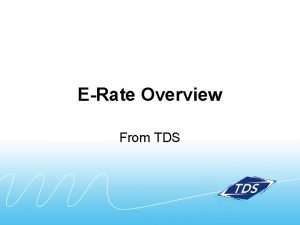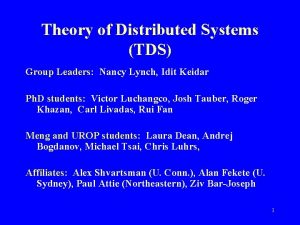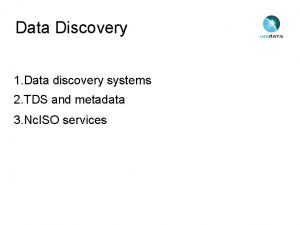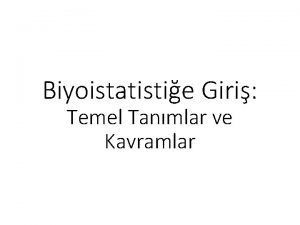DG 0 system DH 0 system TDS 0

























- Slides: 25

DG 0 system = DH 0 system - TDS 0 system DG 0 rxn = S m. DG 0 products - S n. DG 0 reactants

Free Energy and Pressure • • G = G + RT ln(Q) Q = reaction quotient from the law of mass action.

Free Energy and Equilibrium G = RT ln(K) K = equilibrium constant This is so because G = 0 and Q = K at equilibrium.

Free Energy, Equilibrium and Reaction Direction • If Q/K < 1, then ln Q/K < 0; the reaction proceeds to the right ( G < 0) • If Q/K > 1, then ln Q/K > 0; the reaction proceeds to the left ( G > 0) • If Q/K = 1, then ln Q/K = 0; the reaction is at equilibrium ( G = 0) DG = DGo+RT ln Q DG 0 = - RT ln. K

Figure 16. 7: Schematic representations of balls rolling down two types of hills.

atm. (b) The change in free energy to reach equilibrium, beginning with 1. 0 mol B(g) at PB = 2. 0 atm. (c) The free energy profile for A(g) B(g) in a system containing 1. 0 mol (A plus B) at PTOTAL = 2. 0 atm. Each point on the curve corresponds to the total free energy of the system for a given combination of A and B.

Figure 20. 12 The relation between free energy and the extent of reaction DG 0 < 0 K >1 DG 0 > 0 K <1 Copyright © The Mc. Graw-Hill Companies, Inc. Permission required for reproduction or display.


Table 20. 2 The Relationship Between DG 0 and K at 250 C DG 0(k. J) K 100 3 x 10 -18 50 2 x 10 -9 10 2 x 10 -2 1 7 x 10 -1 0 1 -1 1. 5 -10 5 x 101 -50 6 x 108 -100 3 x 1017 -200 1 x 1035 Essentially no forward reaction; reverse reaction goes to completion Forward and reverse reactions proceed to same extent REVERSE REACTION 9 x 10 -36 FORWARD REACTION 200 Significance Forward reaction goes to completion; essentially no reverse reaction

DG and the Work a System Can Do For a spontaneous process, G is the maximum work obtainable from the system as the process takes place: G = workmax For a nonspontaneous process, G is the maximum work that must be done to the system as the process takes place: G = workmax An example

The Law of Mass Action • For • j. A + k. B l. C + m. D • The law of mass action is represented by the equilibrium expression:

Figure 13. 2: The changes in concentrations with time for the reaction H 2 O(g) + CO(g) H 2(g) + CO 2(g) when equimolar quantities of H 2 O(g) and CO(g) are mixed.

Figure 13. 4: The changes with time in the rates of forward and reverse reactions for H 2 O(g) + CO(g)H 2(g) + CO 2(g) when equimolar quantities of H 2 O(g) and CO(g) are mixed. The rates do not change in the same way with time because the forward reaction has a much larger rate constant than the reverse reaction.

Figure 13. 5: A concentration profile for the reaction N 2(g) + 3 H 2(g)-->2 NH 3(g) when only N 2(g) and H 2(g) are mixed initially.


Figure 13. 6: The position of the equilibrium Ca. CO 3(s) Ca. O(s) + CO 2(g) does not depend on the amounts of Ca. CO 3(s) and Ca. O(s) present.

Figure 13. 7: (a) A physical analogy illustrating the difference between thermodynamic and kinetic stabilities. (b) The reactants H 2 and O 2 have a strong tendency to form H 2 O.



Figure 13. 8: (a) The initial equilibrium mixture of N 2, H 2, and NH 3. (b) Addition of N 2. (c) The new equilibrium position for the system containing more N 2 (due to addition of N 2), less H 2, and more NH 3 than in (a).





 Turbidity apes
Turbidity apes The first tds equation is
The first tds equation is Test delivery system
Test delivery system Entalpia
Entalpia Tds on conference hall rent
Tds on conference hall rent Tds relations
Tds relations Dg = dh - tds
Dg = dh - tds Equilibrio quimico
Equilibrio quimico Dg=dh-tds
Dg=dh-tds Tds 210
Tds 210 Easy tds software
Easy tds software Unicorn vs tds
Unicorn vs tds Tds penumbra
Tds penumbra Easy tds software
Easy tds software Ibuprofen 400mg tds
Ibuprofen 400mg tds Tds
Tds Sleger tds
Sleger tds Tdsexpress
Tdsexpress Rocketeer tds
Rocketeer tds Python tds
Python tds Is earth an open or closed system
Is earth an open or closed system Circularory system
Circularory system Caste system versus class system
Caste system versus class system Open system and closed system
Open system and closed system Parliamentary system
Parliamentary system Unitary form
Unitary form
